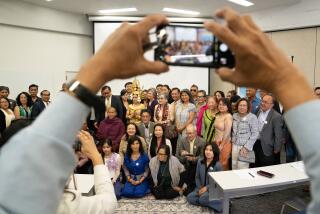Cambodia: Killing fields timeline
- Share via
1925: Saloth Sar, alias Pol Pot, born in central Cambodia.
1949: Pol Pot goes to Paris where he joins a group of young Cambodian revolutionaries, most of them Marxists.
1953: France grants independence to Cambodia under King Norodom Sihanouk; Pol Pot returns to Phnom Penh, trains with Vietnamese communist guerrillas, then works for his cause in the countryside.
1969: Secret U.S. bombing raids begin against Vietnamese communist guerrillas hiding in Cambodia.
1970: Sihanouk deposed by U.S.-backed strongman Lon Nol; the Khmer Rouge and Sihanouk join forces against the nationalists.
1975: The victorious Khmer Rouge arrive in Phnom Penh and evacuate the city; communal farms and work camps are established in the countryside; children older than 7 are separated from their parents.
1976: A new constitution is adopted and the country is renamed Democratic Kampuchea; disenchanted, Sihanouk parts ways with the Khmer Rouge, seeking refuge in North Korea and China.
1977: War begins with long-time enemy Vietnam.
1979: Vietnamese troops enter Phnom Penh and establish a puppet government with current Prime Minister Hun Sen as one of the top officials; Khmer Rouge driven into the countryside.
1985: Khmer Rouge publicly denounces communism but continues to wage war in the north and west.
1989: Vietnam officially withdraws from Cambodia.
1992: Khmer Rouge boycotts elections; top officials defect to the coalition government in Phnom Penh.
1997: Khmer Rouge tribunal established by Cambodia and U.N.
1998: Death of Pol Pot.
2006: Death of Ta Mok, “The Butcher,” while in prison, awaiting trial.
2010: Commandant Duch found guilty of crimes against humanity and sentenced to 35 years in prison. Four top Khmer Rouge leaders indicted, including head of state Khieu Samphan, foreign minister Leng Sary and Pol Pot’s second in command Nuon Chea. All are older than 75.
More to Read
Sign up for The Wild
We’ll help you find the best places to hike, bike and run, as well as the perfect silent spots for meditation and yoga.
You may occasionally receive promotional content from the Los Angeles Times.






